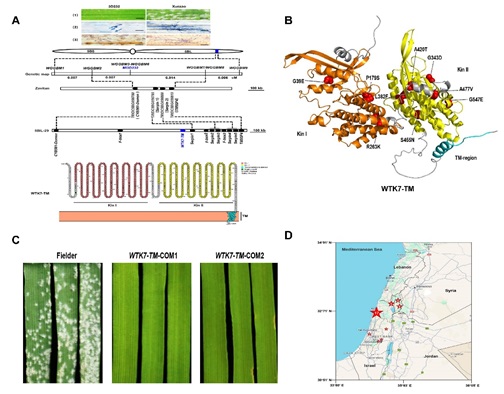Bread wheat is one of the most important staple crops for millions and apparently the largest cultivated and traded cereal worldwide. Bread wheat is a hexaploid species with three subgenome (2
n = 6x = 42, AABBDD) that has undergone two separate allopolyploidization and domestication. Due to the bottleneck effects, modern wheat suffers extremely narrow genetic diversity that led to genetic erosion and increasing susceptibility and vulnerability to environmental stresses, pests, and diseases. Wild emmer wheat,
Triticum dicoccoides, (2
n = 4x = 28, AABB), is the direct wild progenitor for both durum and bread wheats that offers novel
natural variations for modern wheat improvement.
Recently, Researchers from the Institute of Genetics and Developmental Biology (IGDB) of the Chinese Academy of Sciences (CAS) made progress in cloning a broad-spectrum powdery mildew resistance gene
Pm36 that encodes a novel tandem kinase with a transmembrane domain (WTK7-TM) originating from wild emmer wheat.
The results were published online in Nature Communications on April 10, 2024 (DOI: 10.1038/s41467-024-47497-w) entitled “A membrane associated tandem kinase from wild emmer wheat confers broad-spectrum resistance to powdery mildew”.
Pm36 was first identified from wild emmer - durum wheat backcross introgression lines and mapped in 5BL chromosome arm by scientists from the University of Bari, Italy, using amplified fragment length polymorphism (AFLP), simple sequence repeat (SSR), and expressed sequence tag (EST)-derived makers.
Chinese scientist from China Agricultural University developed powdery mildew resistance wild emmer - common wheat backcross introgression line in about the same period of time and fine mapped the same gene using polymorphic SSR, EST-derived sequence tagged site (STS) markers by performing comparative genomic analysis.
In order to clone Pm36, larger segregation population consisting of 31786 gametes was used to fine map Pm36 in a small genomic interval containing only four high-confidence genes according to the available reference genome sequences of wheat and its wild relatives. However, none of them was proven to be Pm36 after the two expressed genes within that interval were separately delivered into highly susceptible wheat cultivar Fielder by Agrobacterium-mediated transformation for functional characterization.
Researchers then wondering if these is genomic structure variation in the Pm36 gene region? Take the advantage of reduced cost of PacBio SMRT long-read sequencing technology, the tetraploid wild emmer-durum introgression line 5BIL-29 carrying Pm36 was sequenced to generate HiFi reads and Hi-C reads for genome sequence assembly. A 7.1 Mb contig ptg000422 spanning the entire Pm36 physical mapping interval (1.17 Mb) was captured from the assembled genome. Unsurprisingly, a large sequence insertion in the Pm36 physical region harboring 7 more predicted genes was found and a putative tandem kinase with predicted transmembrane domain (WTK7-TM) was further confirmed to be the Pm36 gene.
Haplotypic variation analysis revealed that Pm36 (WTK7-TM) only presented in the southern wild emmer gene pool. The absence of Pm36 and several other cloned disease resistance genes, such as Pm41, Yr15 and Yr36, from wild emmer wheat natural habitats from southeastern Turkey where wheat is believed to be domesticated, as well as in cultivated tetraploid and hexaploid wheat, revealed that these disease resistance genes were left behind in the wild and not integrated into the cultivated wheat gene pool.
Most of the cloned wheat resistance genes encode for intracellular nucleotide-binding leucine-rich repeat receptor (NLR) proteins. Wheat tandem kinase (WTK) was recently characterized as a new type of resistance protein in wheat and wild relatives for many kinds of disease resistance, such as stripe rust, stem rust, leaf rust, powdery mildew, and wheat blast. Pm36/WTK7-TM is uncovered from wild emmer wheat and proven to resistant to diversified Blumeria graminis f. sp. tritici isolates. Pm36 has been used to develop advanced breeding lines with broad spectrum resistance and high yield potential to safeguard the food security.
Figure: Map-based cloning ofbroad-spectrum powdery mildew resistance gene Pm36 in wheat (Image by IGDB)
Contact:
Dr. LIU Zhiyong
Institute of Genetics and Developmental Biology, Chinese Academy of Sciences
 Figure: Map-based cloning ofbroad-spectrum powdery mildew resistance gene Pm36 in wheat (Image by IGDB)Contact:Dr. LIU ZhiyongInstitute of Genetics and Developmental Biology, Chinese Academy of SciencesEmail: zyliu@genetics.ac.cn
Figure: Map-based cloning ofbroad-spectrum powdery mildew resistance gene Pm36 in wheat (Image by IGDB)Contact:Dr. LIU ZhiyongInstitute of Genetics and Developmental Biology, Chinese Academy of SciencesEmail: zyliu@genetics.ac.cn CAS
CAS
 中文
中文




.png)
